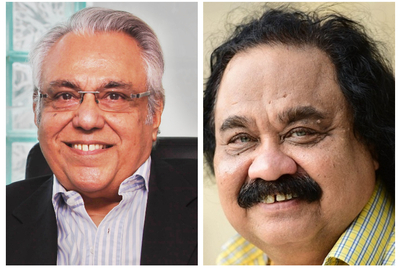
Everyone who knows me knows that I am a hard-core Nipponophile. For well over 25 years now, my New Year resolution has been faithfully crafted as a yojiyukugo (a phrase consisting of 4 Kanji to tell a story or wisdom from the past) and placed on a traditional kakizome (a Japanese calligraphy specifically done on the first day of the year and displayed at your work place or home where it can be easily seen so as to remind you of the goals you have set yourself for the year). Also, for nearly a decade, while I was the Indian JV partner of Dentsu Inc., the world’s largest ad agency and needed to travel to Japan often, I would religiously go pray at the Tsugaoka Hachimangu shrine at Kamakura and perform the ni-rei, ni-hakushu, ichi-rei prayer routine of two-bows, two-claps, one-bow to get the New Year on its way. I did it every year from 2003 to 2011, a must-do visit in the first week of the year to Kamakura. I would also purchase my favourite omamori (charm) to take home for the family or to replace the one in my wallet; and also buy the ema (wooden prayer plaque) to write my wishes and prayers and leave it behind with a thousand others on the shrine precincts to remind the kami (god or deity) of my visit, my dreams and my hopes.
After 25 years, this year I have decided to shift loyalties. You could well say why fix something that ain’t broken? But I think change is the essence of life. So, in 2019, I want to try a new philosophy, a new approach to life. And, this one is Scandinavian.
After much research, much thought and much introspection I have decided that 2019 for me will be the Year of Lagom. Lagom? Well, Lagom is a stress-free Scandinavian life trend; and the Swedish term itself means ‘just enough’. Lagom is about having just the right amount of anything that will make you happy, no more, no less. It is about being content rather than constantly be looking for things to make you happy, if not happier.
“At its simplest, the word Lagom describes something that's 'just enough' or 'just right' – like the right amount of milk in your coffee or the perfect pressure of a mas¬sage,” explains Linea Dunne in her book Lagom: The Swedish Art of Balanced Living. “In the bigger picture, the balance of Lagom goes way behind emotional well-being and interior design to become all about belonging and shared responsibility – not just fitting in, but being part of a greater entity."
My research tells me that the Lexin Swedish-English dictionary defines Lagom as ‘enough, sufficient, adequate, just right’. Lagom is also widely translated as ‘in moderation’, ‘in balance’, ‘perfect-simple’, and ‘suitable’ (in matter of amounts). Whereas words like ‘sufficient’ and ‘average’ suggest some degree of abstinence, scarcity, or failure, Lagom carries the connotation of appropriateness, although not necessarily perfection. The archetypical Swedish proverb ‘Lagom är bäst’, literally means ‘The right amount is the best’, and can also be translated as ‘Enough is a feast in itself’. In the same vein linguists translate the proverb as ‘There is virtue in moderation’.
Somehow I find the whole concept of Lagom very minimal, almost Japanese. Which may actually be one of the reasons for my finding high affinity with the whole thought. In fact Lagom is a sister philosophy to a Danish concept called Hygge which is all about coziness and comfort; all about filling your closet with soft clothes, your home with candles, and your belly with hot tea sipped by a roaring fireplace. Yes, a very warm and soothing Scandinavian way of looking at life. The concept of Lagom, however, helps put Hygge into perspective: encouraging you to use the resources you already have to enjoy your life rather than feel the need to go out and buy more scent¬ed candles, or replace all your per¬fectly serviceable furniture with artisan Nordic wood pieces. And more.
In pursuit of a better understanding of Lagom, I have just finished reading a really nice book, Clear the Clutter. Find Happiness by Donna Smallin Kuper. The book is a very fine read, its essence being that less mess equals less stress. Also that when we have too much stuff, it often results in feelings of being overwhelmed, and displeasure with ourselves and our surroundings. Kuper is an engaging and practical writer (she calls herself a ‘small space-living expert’) and has some interesting perspectives (and good advice) in the book:
- Aim to surround yourself with things you love and use and give yourself permission to let go of the rest.
- Always shop first in your own home. It you look in your clos¬et, you might find something you've forgotten you owned.
- You may have several bottles of shampoo, several soaps, several perfumes that you can use instead of buying more. Also, look at what's in your pantry and create a meal around those ingredients.
- If you're tired of your home decor, try re-arranging some furnishings to give your home a new look. Or shop at second-hand stores instead of going into debt for a new sofa.
- If you want to buy some¬thing you think you really must have, wait a day or two and then re¬consider. You may find that you don't really want it so badly after all.
If nothing else, my wife thinks this is the best New Year resolution I have ever made. I am a compulsive shopaholic and have accumulated many ‘collections’ from my travels all over the world. Many may honestly call my valuable collections pure junk! I have, for example, over 500 Toby mugs that I have bought and painstakingly hand carried from all over the world. My dad thinks I keep buying these ‘toys’ because perhaps he did not buy me enough of the real stuff when I was small. My wife just thinks that whatever I do, I do in excess and I could have been equally happy with a dozen Tobys. Well, in 2019, no more Toby mugs for me.
Lagom at work should also help. I am told Lagom practitioners are bet¬ter communicators because they put egos, hierarchy, and competi¬tion aside, prioritizing listening to each other and building consensus in order to get work done more efficiently and with less friction. Sounds good. I hope it works that way for me in 2019. Similarly food. To eat more Lagom, I am being told to take my time to savour the flavours, and whenever possible not to multitask at meals or eat on-the-go. Lagom practitioners tend to eat more mindfully, generally don't need to eat as much and are less likely to overeat. This is all music to my wife’s ears. Only she doubts how long my Lagom fascination shall last.
My wife may well be right. My track record on New Year resolutions has been fairly poor over the years. But for now, I am both excited and very consumed by the whole Lagom concept. The more I read about it, the more fascinated I am. I just discovered, for example, that the origin of the term
Lagom is actually an archaic dative plural form of lag (law). This law is not judicial law but common sense law. This connects with a popular folk etymology where laget om (around the team) was a phrase used in Viking times to specify how much mead one should drink from the horn as it was passed around in order for everyone to receive a fair share. Nice. Very nice.
Well, 2019 will soon be here. I am committing myself perhaps to a slightly difficult readjustment and recalibration in the New Year … it is not to live life louder, faster, richer or even better. It is to do just enough. No more, no less.
My daughter thinks I am just getting old.
I really don’t know.
 (Dr. Sandeep Goyal hopes 2019 will be a year of contentment, happiness and tranquility. For him, and for everyone else.)
(Dr. Sandeep Goyal hopes 2019 will be a year of contentment, happiness and tranquility. For him, and for everyone else.)


.jpg&h=334&w=500&q=100&v=20250320&c=1)

.jpg&h=334&w=500&q=100&v=20250320&c=1)
.jpg&h=334&w=500&q=100&v=20250320&c=1)

.jpg&h=334&w=500&q=100&v=20250320&c=1)










.png&h=268&w=401&q=100&v=20250320&c=1)

